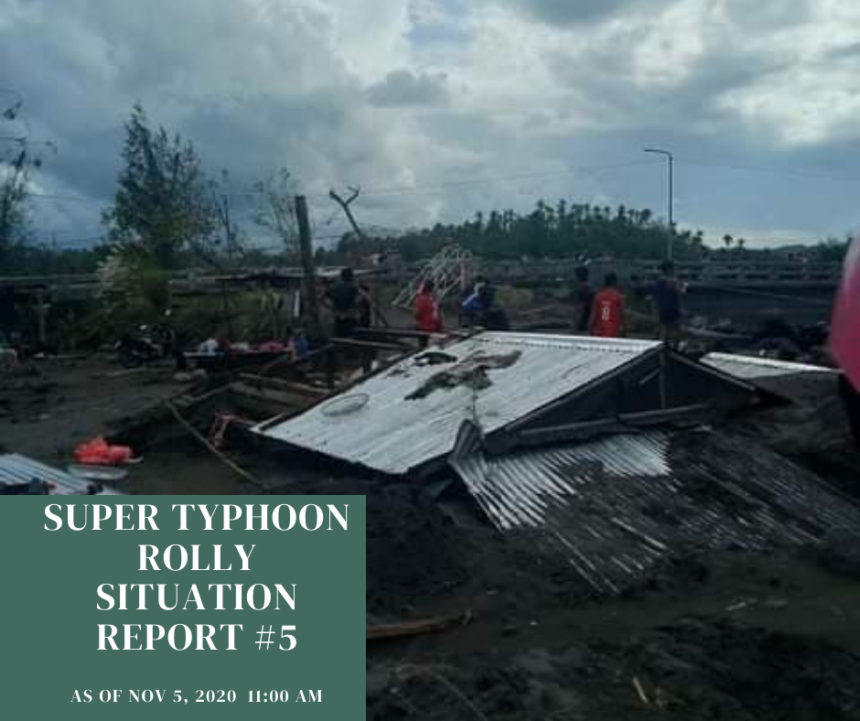Situation Overview
Typhoon Rolly (International name “Goni”) entered the Philippine Area of Responsibility (PAR) on October 31. It was categorized as a super typhoon as it made land fall over the Bicol Region twice on Sunday November 1. It first hit the municipality of Bato, Catanduanes peaking with sustained winds of 225 kph near the center and gustiness of up to 280 kph. Two hours later, after passing Catanduanes, TY Rolly battered Tiwi, Albay with almost the same intensity placing the entire Bicol Region in a precarious situation. It made its third land fall in San Narciso, Quezon and at 5:30 pm of the same day, TY Rolly made its fourth land fall in Lobo, Batangas before rapidly downgrading into a tropical storm over the West Philippines Sea.
On November 3, Typhoon Rolly exited PAR and left in its wake billions of pesos worth of damages in crops and destroyed homes and infrastructures, reaching over P6 billion. Overall, Rolly had devastating effects especially on Albay and the island of Catanduanes as it reached category 5 intensity when it reached the two provinces.
(Source: DOST –PAGASA Severe Weather Bulletin)
Affected Populations
As of this writing, at least 20 have died from the typhoon (14 from Albay, 6 in Catanduanes), 74 injured and three (3) missing persons are reported in Regions CALABARZON, MIMAROPA and V, but the number of fatalities is expected to increase as more areas become accessible and search and operations continues according to the National Disaster Risk Reduction and Management Council (NDRRMC).
In a recent assessment conducted by our regional partners in Quezon, where TY Rolly made its 3rd landfall, a total of 1,301 families were displaced from the Municipality of San Andres and San Narciso. The people are temporarily sheltered in evacuation centers-mostly in school buildings, barangay offices, and churches.
Serious flooding and significant damages are also reported in Daraga, Albay, Batangas City, and Laguna because of the heavy rains brought by Typhoon Rolly.
The latest figures indicates that a total of 226,686 families or 895,841 persons were affected in 3,543 barangays in Regions NCR,II,III, CALABRAZON, MIMAROPA,V,VIII and CAR, while a total of 132,163 families or 480,174 have been displaced and have sought temporary shelters in schools, barangay halls and other evacuation centers. Electricity has been cut, particularly in the most provinces of Bicol Region as electricity poles have been severely damaged. Water works and communication signals have been damaged by the typhoon as well. Power interruptions are still experience in 151 municipalities in Regions V, VIII, MIMAROPA and CALABARZON while water outage is still present in 84 municipalities in MIMAROPA and Region V due to TY Rolly. Progress continues in restoring electricity and communication capacity according to Department of Electricity (DOE), however it will take 2 months in Albay to restore their electricity lines as 77 major electric poles were severely damaged. In Catanduanes, about 60% of electric poles were toppled by the typhoon making it hard for its municipalities to get on back on their feet again.
The ravaged of TY Rolly also left 14,064 totally damaged houses and 29, 969 received partially damage while a total of 418 passengers are stranded in various ports of Region V, VIII, CALABARZON and MIMAROPA during onslaught of TY Rolly.
(Source: DROMIC DSWD, Southern Tagalog People’s Response Center, DOE, NDRRMC)
Emergency Response Efforts
• Since October 31, CDRC has been continually monitoring the situation through weather bulletins posted by PAGASA and through its regional networks in the affected areas and started releasing its situation reports.
• CDRC is coordinating with different agencies and organisations such as CARE Philippines, DKH, Mercy Relief, Musika Publiko, GlobalGiving, and iVolunteer to raise funds and donations for the affected communities.
• CDRC’s assessment teams have been deployed to support its Regional Centers including Tarabang para sa Bicol, Inc. (TABI) and Southern Tagalog People’s Response Center (STPRC) and other partners in the affected areas to initiate damages, needs, and capacity assessments and to mobilize local resources to ensure that some of the unmet needs of the survivors will be fulfilled.
Resources Available
• Standby emergency funds
• Prepositioned goods at the CDRC warehouse
• Monetary and in-kind donations
Expressed Needs
• Access to immediate food packs is considered one of the preliminary needs in the most affected regions. The other most pressing needs includes, clean water, medicines, sleeping supplies, sanitation kits, and face mask as the country is still coping with the COVID-19 Pandemic. Major repairs are needed to restore electricity supply and communication lines. Livelihood support for the affected farmers is also a major concern.
Coordination
Regional Centers
• Tarabang para sa Bicol, Inc. (TABI)
• Southern Tagalog People’s Response Center, Inc. (STPRC)
• Alay-Bayan Luzon, Inc. (ABI)
• Community Response for Enlightenment, Service and Transformation, Inc. (CREST)
• Leyte Center for Development, Inc. (LCDE)
Partners
• Disaster Preparedness Organizations/Committees (DPO/Cs)
• Peoples Organizations (POs)
• Musika Publiko
• iVolunteer Philippines
• Diakonie Katastrophenhilfe (DKH)
• CARE Philippines
• GlobalGiving
• Mercy Relief
• World Jewish Relief
• UN OCHA
Government agencies
• Municipal and Barangay Local Government Units in San Narciso, Mulanay, San Andres, Buenavista, Lopez, and Catanauan in Quezon Province
• Municipal Social Welfare Development Offices of San Narciso and Catanauan, Quezon
• Municipal Agriculture and Municipal Disaster Risk Reduction and Management Offices of Mulanay, Quezon
• Barangay LGUs in San Juan, Batangas and Batangas City
Contacts
• Hanna Fiel, Deputy Executive Director, 0945-8355589, hanna.fiel.cdrc2019@gmail.com
• Cora Jazmines, Local Partnerships Department, 0928-1824969, lpd@cdrc-phil.com

